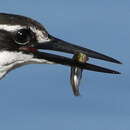Diagnostic Description
provided by Fishbase
Diagnosis: Body rather compressed, belly rounded, with 6 to 9 thin unkeeled pre-pelvic scutes followed by an equally thin pelvic scute, all with slender ascending arms; no post-pelvic scutes; snout pointed, lower jaw a little prominent, with a single row of fine teeth in each jaw; posterior supra-maxilla paddle-shaped; gillrakers 39 to 76, gillrakers small but present on posterior face of third epibranchial; pelvic fin with i-7 finrays, under or a little before dorsal fin origin (Ref. 188). Resembles Spratelloides species or juvenile Etrumeus and Dussumieria, but pre-pelvic scutes present; other clupeids occuring in same area have keeled pre-pelvic and post-pelvic scutes (Ref. 188).Description: Body compressed, fusiform; belly rounded; fins short, pectorals low on body, pelvics before dorsal, anal long-based, caudal forked (Ref. 3259; 7248, 52193). Mouth upturned, eyes large (Ref. 7248, 52193). Upper jaw rounded when seen from front (Ref. 188). Lower gillrakers apparently highly variable, 39-76 (Ref. 3259, 118219). Dorsal fin with 3 unbranched and 11-12 branched rays; anal fin with 3 unbranched and 17 branched rays; pectoral fin with 1 unbranched and 10-11 branched rays; pelvic fin with 1 unbranched and 7 branched rays; pelvic fin base in front of dorsal fin base; pelvic fin reaching more than halfway to anus (Ref. 3259, 7248, 52193). Scales light and easily shed, about 40 in longitudinal series; transverse scales 9-10 (Ref. 7248, 52193, 118219). Belly with 6-9 thin scutes before pelvic fin, only visible when belly scales removed and surface dried; no post-pelvic scutes (Ref. 3259).Colouration: Silvery; top and sides of head and body thickly sprinkled with black dots; brilliant silver lateral stripe, on hind part of side; back dark (Ref. 3259, 36031). In alcohol: a uniform light brown with a faint midlateral silvery band; individual bases of dorsal and anal rays black pigmented; two short dark pigment lines at base of anal, one almost horizontal along upper border, the other oblique on lower border (Ref. 118219).
- Recorder
- Crispina B. Binohlan
Life Cycle
provided by Fishbase
A semelparous species that grows to maturity and spawns in one year (Ref. 34361).
Migration
provided by Fishbase
Amphidromous. Refers to fishes that regularly migrate between freshwater and the sea (in both directions), but not for the purpose of breeding, as in anadromous and catadromous species. Sub-division of diadromous. Migrations should be cyclical and predictable and cover more than 100 km.Characteristic elements in amphidromy are: reproduction in fresh water, passage to sea by newly hatched larvae, a period of feeding and growing at sea usually a few months long, return to fresh water of well-grown juveniles, a further period of feeding and growing in fresh water, followed by reproduction there (Ref. 82692).
- Recorder
- Crispina B. Binohlan
Morphology
provided by Fishbase
Dorsal spines (total): 0; Dorsal soft rays (total): 14 - 15; Analspines: 0; Analsoft rays: 20
- Recorder
- Crispina B. Binohlan
Trophic Strategy
provided by Fishbase
Occurs in the sea, but found mostly in estuaries; also found in landlocked brackish and freshwater lagoons (Ref. 93596), also rivers and lakes (Ref. 188). Entire life cycle is completed in the estuary (Ref. 32693). Feeds chiefly on zooplankton by filtering or selecting individual organisms from the water column (Ref. 7248, 52193). It can tolerate salinities under 4 ppt and of up to 52.6 ppt (Ref. 32693).
Biology
provided by Fishbase
Occurs in the sea, but found mostly in estuaries; also found in landlocked brackish and freshwater lagoons (Ref. 93596), also rivers and lakes (Ref. 188). Maximum size 10 cm (Ref. 4967). Entire life cycle is completed in the estuary (Ref. 32693). Breeds throughout the year with a peak in spring and early summer (Ref. 7248, 52193). Maturity may be attained within the first or second year and an age of up to 5 or 6 years is recorded (Ref. 7248, 52193). Feeds chiefly on zooplankton by filtering or selecting individual organisms from the water column (Ref. 7248, 52193). It can tolerate salinities under 4 ppt and of up to 52.6 ppt (Ref. 32693). Utilized fresh or dried and salted (Ref. 12484).
- Recorder
- Crispina B. Binohlan
Importance
provided by Fishbase
fisheries: subsistence fisheries; bait: usually
- Recorder
- Crispina B. Binohlan
Gilchristella: Brief Summary
provided by wikipedia EN
Gilchristella aestuaria, the Gilchrist's round herring or estuarine round-herring, is a member of the herring family Clupeidae that occurs off the coasts of Southern Africa. It is the only species in its genus, which was named for John Dow Fisher Gilchrist (1866–1926).
- license
- cc-by-sa-3.0
- copyright
- Wikipedia authors and editors

